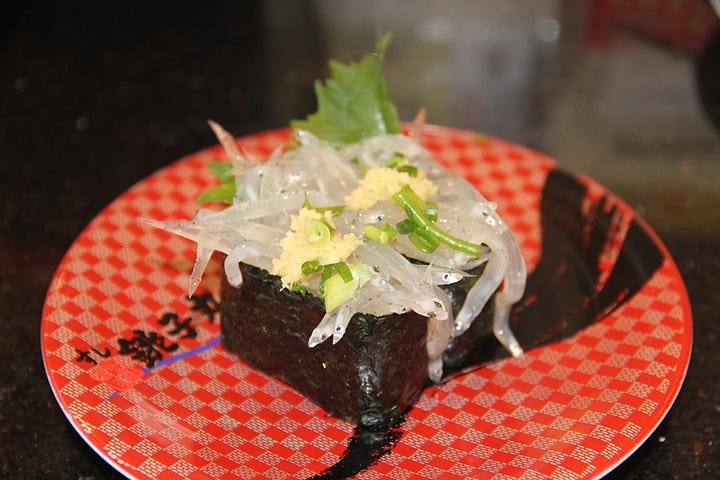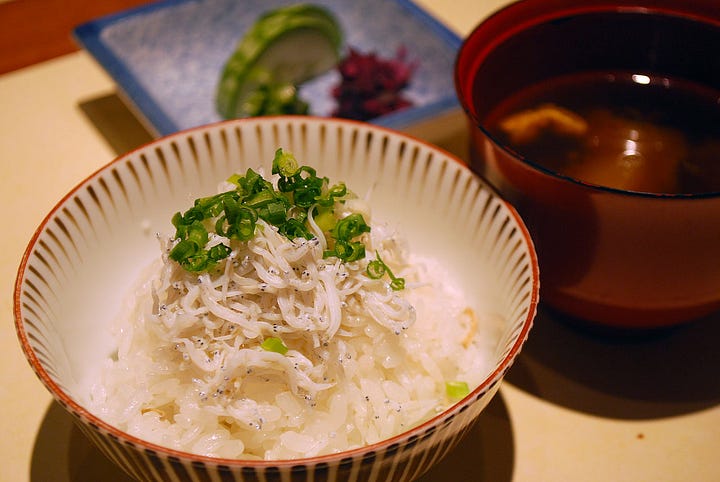February 14 - 18
魚上氷
うお こおりを いずる
Uo kōri wo izuru
"Fish emerge through thinning ice"
(This is the second post about this microseason—if you missed the first one, you can find it here to catch up!)
With the waning of winter, the sun increases in strength. The longer days and added warmth begin to thin out the layers of ice and snow blanketing the waterways and forests. For those slumbering underneath, it’s time to wake up and rise to the surface.
As more and more sunlight reaches into the rivers and lakes of Japan, its aquatic life stirs.
As a nation of islands in the Pacific, with abundant lakes and streams, it shouldn’t surprise that fish and their movements are important in Japan and remarked upon here in the Koyomi’s microseasons. After all, “sushi” would be pretty likely to come up in a conversation with a random person on the street about the country.1 Even today, Japan maintains one of the world’s largest commercial fishing fleets, and accounts for nearly 15% of the global catch, ranking 4th in the world in total tonnage. There are at least 2,000 commercial fishing ports in the country (On average, Japanese people eat more fish and seafood than most other populations, with a majority of people eating it 2-3 times a week.
Of course, your average modern family isn’t out there, rod in hand, catching their weekly fish. But sport and game fishing are reasonably popular, and this microseason lines up with the start of the allowed mountain stream fishing season: keiryū-zuri (渓流釣り)2. During this early spring, anglers are mainly after iwana (岩魚, char), which literally means “rock fish” due to their tendency to hide among river rocks.
Also emerging from the ice are fish like yamame (山女魚, landlocked trout) and shira-uo (白魚, icefish or “noodlefish”). The latter is similar in appearance to shirasu (しらす), or “whitebait,” which is a catch-all term for the immature fry of several different species of fish. Whitebait are fished later in spring after their species have spawned, but this has become subject to controversy (in many countries where they’re eaten) due to its impact on those species’ natural life cycles.
Shira-uo also have a somewhat cheeky nickname: tonosama-uo (殿様魚), or “daimyo fish.” This being a bit of a jab at how the fish’s slender, nearly translucently pale appearance is reminiscent of the hands of a feudal lord that has never had to work a field outside.


Before becoming a nation of rice-farming, Japan was a nation of fishing. The islands’ earliest populations lived along the coasts, gradually moving inland as technology and agriculture allowed. Even then, as a slim, mountainous country created by volcanoes, only about 20% of Japan’s land area is viable for farming (and people have to live on some of it). It has long been one of the country’s key industries, and even for those who have never held a fishing rod in their lives, the sense of seasonality in what fish are available and at peak demand is more generally widespread than in other countries. Ultra-modern conveyor belt sushi restaurants will be plastered with eye-catching graphics about the month’s top recommended types of fish, and the Toyosu Fish Market remains one of Japan’s top tourist attractions.
While a popular sport among wealthy nobles in the Nara and Heian periods (8th~12th centuries), fishing as a recreational hobby for the common man didn’t really take off in Japan until the Edo period (16th-18th century). Aside from advances in technology and commerce that made securing food less of a pressing day-to-day concern, centuries without any wide-scale war allowed the working class and burgeoning middle class to partake in more leisure activities. Put another way: when people are comfortable and safe, they have time for fun.
In the city of Edo itself (modern-day Tōkyō), a network of engineered waterways ran through all parts of town, allowing for residents to enjoy a bit of urban fishing. These could be considered the earliest ancestors of the popular indoor fishing centers that can be found at some Japanese arcades and recreation areas.



Even if you’re not relying on it for food, or a keen sportsman with the latest Shimano brand gear, there’s an unmistakable sense of renewed life in the leaping motion of fish breaking the stillness of previously frozen waters. Have you ever had a walk near a river or lake at twilight? Every once in a while, you may catch a flash of movement, or hear the distant sound of a splash. You remember that under that mirrored surface is an entire world.
The waters are warming, the ice is breaking up, and nature is becoming a little more lively. Even if fish aren’t jumping into the air, they are waiting just under the surface, warming their bones and bodies.
See you next kō~
[Images & info courtesy of kurashikata.com, kurashi-no-hotorisya.jp, 543life.com, and Wikipedia except where otherwise noted]
As it happens, sushi was invented as a way to preserve fish—its earliest incarnations basically being pickled fish made with fermented rice that was then discarded
The modern version of the classic dish (bite-sized slices of fish on vinegared rice) is thought to have been created in the 1800s as a form of fast food in Tokyo for the working class
A quick note on spelling Japanese with English characters—there are two main styles of writing out Japanese words in what’s called romaji (ローマ字), the Latin alphabet: the Hepburn style (ヘボン式, hebon-shiki) and Kunrei style (訓令式, kunrei-shiki)
Hepburn romanization, as it’s officially known, is named after James Curtis Hepburn, a Presbyterian missionary who published the first Japanese-English dictionary in 1867, whereas Kunrei, developed in 1881, was originally known simply as nihon-shiki (“Japanese style”) owing to its domestic creation and more careful alignment with how Japanese phonemes work to native speakers, rather than to foreign listeners—there have been fights over which to use ever since
The main differences mainly lie with Japanese phonemes that don’t neatly match up to English ones, or fall between: for example, the sound ふ can be either fu or hu depending on the speaker, their region, the listener’s ears, etc… likewise し is either shi or si, and ちゃ either cha or tya
I mention it here because the word for fishing is tsuri (つり), whose initial syllable changes when in a compound word like this to zuri (づり), but the sound is more like dzuri, with both the “t” and “s” softening
While the Japanese Government’s official policy (up until January this year) was to use Kunrei, Hepburn has been the more popular choice domestically and abroad for a long while—it’s my personal preference, so it’s what’s used in this newsletter with occasional non-standard changes for broader readability (the use of vowel-extending macrons, for example)
Okay, maybe that note wasn’t so quick






